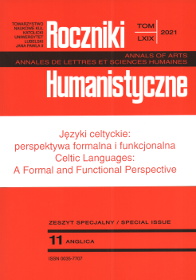Acoustic Features of Burst Release: A Study of Welsh Plosives
Abstrakt
Cechy akustyczne środka ciężkości plozji: studium walijskich spółgłosek zwarto-wybuchowych
Celem niniejszego artykułu jest przeanalizowanie środka ciężkości plozji walijskich spółgłosek zwarto- wybuchowych co pozwoliłoby ocenić znaczenie tego czynnika w rozróżnianiu między /p, t, k/ (w artykule określane jako mocno artykułowane – fortis) a /b, d, g/ (w artykule określane jako słabo artykułowane – lenis). Środek ciężkości plozji wydaje się szczególnie interesujący ponieważ: (i) nie był jeszcze dogłębnie analizowany w badaniach fonetycznych walijskich spółgłosek zwarto-wybuchowych (por. Ball 1984; Ball i Williams 2011; Jones 1984; Morris i Hejná 2019) oraz (ii) używanie środka ciężkości plozji jako czynnika różnicującego między spółgłoskami zwarto-wybuchowymi jest dosyć rzadkie, jako że tego czynnika używa się zwykle do różnicowania między spółgłoskami szczelinowymi o różnych miejscach artykulacji. Aby osiągnąć wspomniane wcześniej cele, autorzy artykułu, zainspirowani badaniem spółgłosek zwarto-wybuchowych amerykańskiej odmiany języka angielskiego przeprowadzonym przez duet Chodroff i Wilson (2014), zmierzyli środek ciężkości plozji w nagłosie dla /p, b, t, d, k, g/.
Bibliografia
Asmus, Sabine, and Sven Grawunder. Vowel Length in Welsh Monosyllables, Its Interrelation with Irish and Related Problems. Edwin Mellen Press, 2017.
Asmus, Sabine, Sylwester Jaworski, and Michał Baran. “Fortis-Lenis or Voiced-Voiceless – Features of Welsh Consonants.” Proceedings of the 19th International Congress of Phonetic Sciences, edited by Sasha Calhoun et al., Australasian Speech Science and Technology Association, 2019, pp. 3773–3776.
Asmus, Sabine, Sylwester Jaworski, and Michał Baran. “Fortis-Lenis vs Voiced-Voiceless Plosives in Welsh.” Linguistics Beyond and Within, vol. 6, 2020, pp. 5–16.
Ball, Martin J. “Phonetics for Phonology.” In Welsh Phonology. Selected Readings, edited by Martin J. Ball and Glynn E. Jones, Cardiff: U of Wales P, 1984, pp. 5–39.
Baran, Michał. “Fortis-Lenis Distinction of Fricatives and Plosives in Welsh – Phonetically Distinctive Factors.” Linguistics Beyond and Within, vol. 6, 2020, pp. 47–59.
Bickford, Anita C., and Rick Floyd. Articulatory Phonetics: Tools for Analyzing the World’s Languages. SIL International, 2006.
Boersma, Paul, and David Weenink. “Praat: Doing Phonetics by Computer” (version 5.3.43) (DOA December 18, 2019), 2019.
Chodroff, Eleanor, and Colin Wilson. “Burst Spectrum as a Cue for the Stop Voicing Contrast in American English.” The Journal of the Acoustical Society of America, vol. 136, no. 5, 2014, pp. 2762–2772.
Chodroff, Eleanor, and Colin Wilson. “Acoustic–Phonetic and Auditory Mechanisms of Adaptation in the Perception of Sibilant Fricatives.” Attention, Perception and Psycholinguistics, vol. 82, 2019, pp. 2027–2048.
Cruttenden, Alan. Gimson’s Pronunciation of English. Arnold, 1996.
Davenport, Mike, and S. J. Hannahs. Introducing Phonetics and Phonology. Routledge, 2005.
Harrington, Jonathan. Phonetic Analysis of Speech Corpora. Wiley-Blackwell, 2010.
Halle, Morris, George W. Hughes, and Jean-Pierre Radley. “Acoustic Properties of Stop Consonants.” The Journal of the Acoustical Society of America, vol. 29, no. 1, 1957, pp. 107–116.
Howitt, Dennis, and Duncan Cramer. Introduction to Statistics in Psychology. Pearson Education, 2005.
Hyman, Larry. Phonology: Theory and Analysis. Holt, Rinehart and Winston, 1975.
Iosad, Pavel (forthcoming) “The ATR/Laryngeal Connection and Emergent Features.” Primitives of Phonological Structure, edited by Bert Botma and Marc van Oostendorp.
Jones, Glyn E. “The Distinctive Vowels and Consonants of Welsh.” Welsh Phonology. Selected Readings, edited by Martin J. Ball and Glynn E. Jones, U of Wales P, 1984, pp. 40–64.
Kirkham, Sam. “The Acoustics of Coronal Stops in British Asian English.” Proceedings of the 17th International Congress of the Phonetic Sciences, edited by Wai Sum Lee and Eric Zee, City University of Hong Kong, 2011, pp. 1102–1105.
Ladefoged, Peter, and Ian Maddieson. The Sounds of the World’s Languages. Blackwell Publishers, 1996.
Lisker, Leigh. “How is the Aspiration of English /p, t, k/ ‘Predictable’?” Language and Speech, vol. 27, no. 4, 1984, pp. 391–394.
Maddieson, Ian. Patterns of Sounds. Cambridge UP, 1984.
Morris, Jonathan, and Míša Hejná. “Pre-aspiration in Bethesda Welsh: A Sociophonetic Analysis.” Journal of the International Phonetic Association, vol. 50, no. 2, 2019, pp. 1–25.
Ogden, Richard. An Introduction to English Phonetics. Edinburgh UP, 2009.
Stevens, Kenneth. Acoustic Phonetics. MIT Press, 1998.
Sundara, Megha. “Acoustic-Phonetics of Coronal Stops: A Cross-Language Study of Canadian English and Canadian French.” The Journal of the Acoustical Society of America, vol. 118, no. 2, 2005, pp. 1026–1037.
Thomas, Richard J. Geiriadur Prifysgol Cymru. A Dictionary of the Welsh Language. U of Wales P, 1950.
Trask, Robert L. Dictionary of Phonetics and Phonology. Taylor and Francis Routledge, 1996.
van Alphen, Petra M., and Roel Smits. “Acoustical and Perceptual Analysis of the Voicing Distinction in Dutch Initial Plosives: The Role of Pre-voicing.” Journal of Phonetics, vol. 32, no. 4, 2004, pp. 455–491.
Vicenik, Chad. “An Acoustic Study of Georgian Stop Consonants.” The Journal of the International Phonetic Association, vol. 40, no. 1, 2010, pp. 59–92.
Wells, John C. The Longman Pronunciation Dictionary. Longman Group, 1990.
Zue, Victor W. Acoustic Characteristics of Stop Consonants: A Controlled Study. PhD dissertation. MIT Press, 1976.
Copyright (c) 2021 Roczniki Humanistyczne

Utwór dostępny jest na licencji Creative Commons Uznanie autorstwa – Użycie niekomercyjne – Bez utworów zależnych 4.0 Międzynarodowe.





